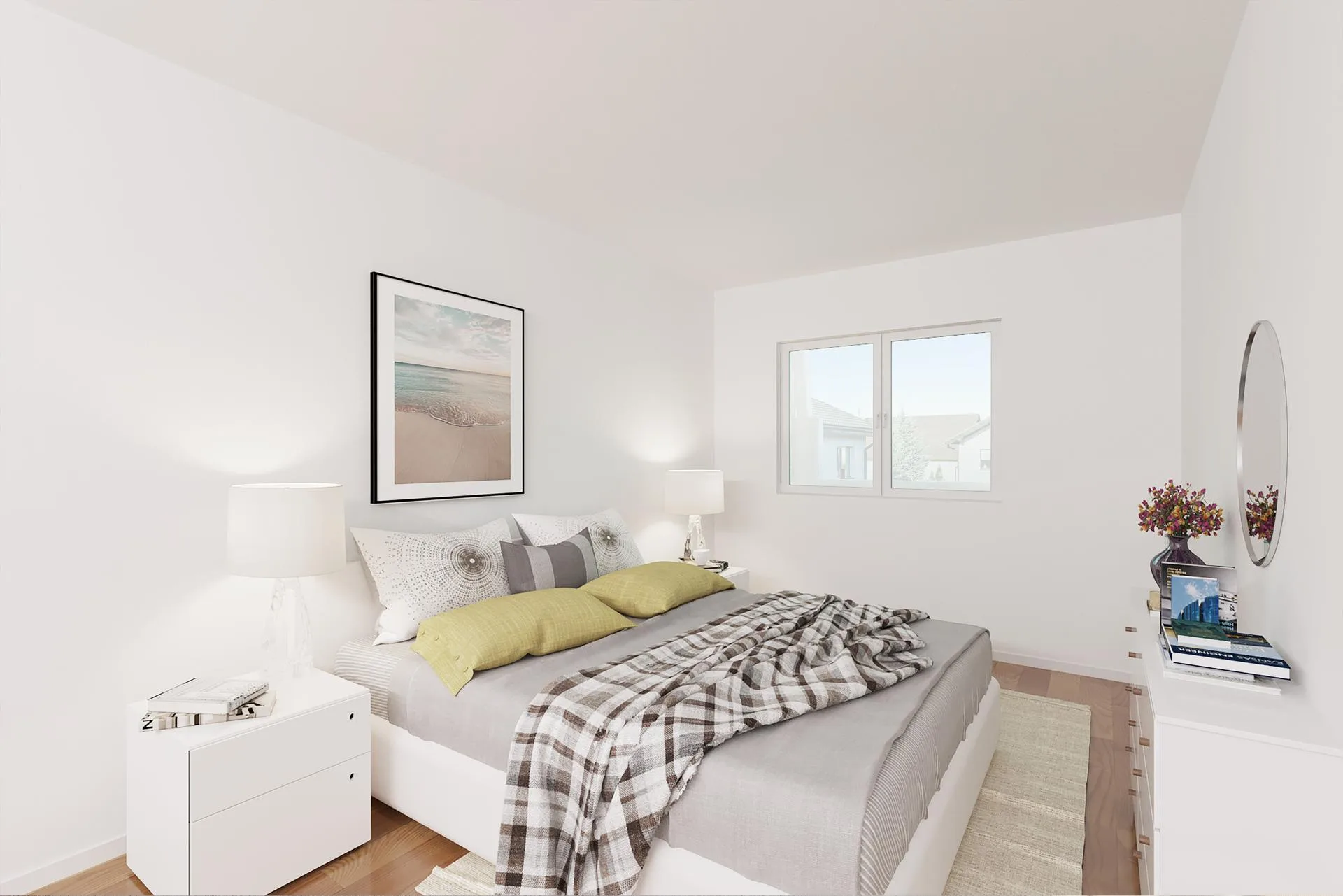
Virtual Staging for Small Spaces: 3 Tips Making the Most of Limited Square Footage
Introduction
Virtual Staging for Small Spaces is a game-changer in the real estate industry. With the increasing demand for affordable housing, many buyers are looking at smaller properties. However, small spaces come with their own set of challenges, primarily revolving around making a good first impression. This blog explores how virtual staging can transform small spaces, making them appear larger and more appealing to potential buyers.
If you are still wondering about Virtual Staging, read our article “What is virtual staging?”
Further reading:
- The Effective Impact of Virtual Staging in Real Estate Sales
- Virtual Staging vs. Home Staging: Which is Right for You?
- Home Staging & Virtual Staging Statistics for Home Sellers (2024)
The Challenge of Small Spaces

Before: Empty Room

After: Virtual Staging by Digihomestudio.com
Virtual Staging for Small Spaces begins with understanding the unique constraints these properties present. Limited square footage can make it difficult for potential buyers to envision how they will use the space effectively. Small rooms often feel cramped, and poorly furnished spaces can exacerbate this perception.
One of the most significant hurdles in selling small properties is overcoming the initial negative impression. Buyers often decide within seconds whether a property is worth considering, and cluttered, unstaged small spaces can lead to immediate disinterest. It is essential to create a welcoming, spacious, and functional environment that highlights the potential of the property.
Benefits of Virtual Staging for Small Spaces
Virtual Staging for Small Spaces offers several benefits that can help overcome the inherent challenges of limited square footage. One of the primary advantages is space maximization. By strategically placing virtual furniture, you can create the illusion of more space. For instance, using appropriately scaled furniture and arranging it to enhance the flow can make rooms appear larger and more functional.
Another significant benefit is cost-effectiveness. Traditional staging can be expensive, especially when dealing with multiple small properties. Virtual Staging is a budget-friendly alternative that eliminates the need for physical furniture and decor. This method allows real estate agents and homeowners to present their properties in the best light without incurring high costs.
Flexibility in design is another compelling advantage. Virtual Staging allows you to experiment with different layouts and styles without any physical limitations. This flexibility means you can tailor the staging to suit various target audiences, making the property more appealing to a broader range of potential buyers.
Key Strategies for Effective Virtual Staging for Small Spaces
Virtual Staging for Small Spaces requires careful planning and execution to be effective. One of the key strategies is choosing the right furniture. Selecting furniture that fits the scale of the room is crucial. Multifunctional and compact pieces are ideal as they save space while adding functionality. For example, a sofa bed or a fold-out dining table can be great additions to a small apartment.
Utilizing light and color is another critical strategy in Virtual Staging. Light colors can make a room feel more open and airy. Mirrors strategically placed can reflect light and give the illusion of more space. Proper lighting is also essential; well-lit rooms appear larger and more inviting.
Decluttering and embracing minimalism are vital in Virtual Staging for Small Spaces. A clean, uncluttered look helps to make small spaces feel larger and more open. Removing unnecessary items and keeping the decor simple can significantly impact the perception of space.
3 Tips Making Virtual Staging for Small Spaces

Virtual Staging by Digihomestudio.com
- Virtual Staging for Small Spaces involves various practical tips and techniques to maximize the impact. Virtual furniture placement is a crucial element. Arranging furniture to enhance flow and functionality can make a significant difference. Avoid overcrowding the space; instead, focus on creating clear pathways and open areas.
- Creating focal points is another effective technique in Virtual Staging for Small Spaces. Focal points draw attention away from the size of the room and towards its best features. For instance, a beautiful virtual painting or a stylish piece of furniture can serve as a focal point, diverting attention from the room’s limitations.
- Virtual enhancements such as adding virtual windows, plants, or artwork can improve the ambiance of a space. These additions can make the room feel more lively and welcoming, enhancing the overall appeal.
Examples of Virtual Staging for Small Spaces
Virtual Staging for Small Spaces can be best understood through real-world examples and case studies. Before-and-after comparisons are particularly effective in demonstrating the transformation. For example, a small, cluttered living room can be virtually staged with appropriately scaled furniture, light colors, and minimal decor to appear more spacious and inviting.

Before: Empty Room

After: Virtual Staging by Digihomestudio.com
Highlighting specific virtual staging software used in the example can also be beneficial. Good news: You can create professional staged photo listings faster with Digihomestudio.com to increase your sales.
It’s undeniable that virtual staging offers significant long-term cost savings. Let’s break down the costs involved. By partnering with a trusted virtual staging service provider such as Digihomestudio.com, you can expect to invest around $29 for a meticulously designed and lifelike final image, suitable for showcasing your home across various digital platforms.
We have a network of world-class virtual stage editors and designers in Vietnam. To ensure the best level of service, the customer service team is located in the US.
Our virtual home staging services include:
- Staging for empty or furnished rooms
- Change the color of the walls and floors
- Virtual renovation
- Erase furniture and small objects
- And much more!
If you’re prepared to elevate your real estate marketing strategies, reach out to Digihomestudio.com now and experience the benefits of collaborating with one of the top virtual staging firms available today.
Common Mistakes to Avoid in Virtual Staging for Small Spaces
Virtual Staging for Small Spaces can sometimes go wrong if certain pitfalls are not avoided. One common mistake is over-staging. Over-furnishing or over-decorating small spaces can make them feel even more cramped. It’s essential to strike a balance between showing functionality and keeping the space open.
Ignoring scale is another mistake to avoid in Virtual Staging for Small Spaces. Furniture that is too large can overwhelm a room, while too small can make the space feel awkward. Maintaining the correct scale and proportion is crucial to achieving a harmonious and spacious look.
Lack of cohesion in design can also detract from the effectiveness of virtual staging. Ensuring that the design theme is consistent throughout the space is essential. A cohesive design ties the room together, making it more aesthetically pleasing and easier for potential buyers to visualize themselves living there.
Conclusion
Virtual Staging for Small Spaces is an invaluable tool in the real estate market. By understanding the challenges, leveraging the benefits, and implementing key strategies, you can transform small properties into attractive, functional, and desirable homes. Recapping the main points, virtual staging maximizes space, is cost-effective, and offers flexible design options. It’s a powerful solution for making a positive first impression on potential buyers.





Leave a Reply